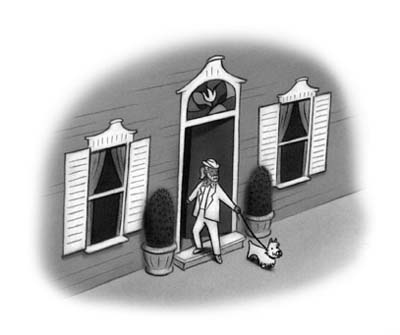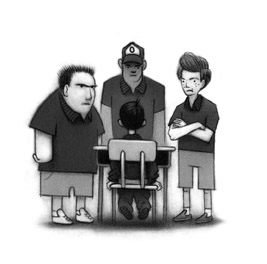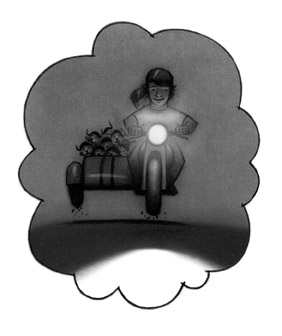Co-Review: Kaline Klattermaster’s Tree House
 February 11th, 2008 by Eisha and Jules
February 11th, 2008 by Eisha and Jules
 Jules: If you’re a loyal reader of 7-Imp, you know Eisha and I have what could easily pass for a virtual fan club here at this blog for author Haven Kimmel, the creator of the two Zippy memoirs (this one and this one for which you should drop everything and read if you haven’t already) as well as the books in what is called her Hopwood Trilogy — The Solace of Leaving Early, her debut novel; Something Rising (Light and Swift); and last year’s The Used World (which Eisha and I co-reviewed at ForeWord Magazine’s Shelf Space in October of last year). More on those books and our undying devotion to her as an author are in this interview with her, conducted almost one year ago.
Jules: If you’re a loyal reader of 7-Imp, you know Eisha and I have what could easily pass for a virtual fan club here at this blog for author Haven Kimmel, the creator of the two Zippy memoirs (this one and this one for which you should drop everything and read if you haven’t already) as well as the books in what is called her Hopwood Trilogy — The Solace of Leaving Early, her debut novel; Something Rising (Light and Swift); and last year’s The Used World (which Eisha and I co-reviewed at ForeWord Magazine’s Shelf Space in October of last year). More on those books and our undying devotion to her as an author are in this interview with her, conducted almost one year ago.
Haven has a new children’s book (geared officially at the “7-12” age range), just released at the beginning of February by Atheneum Books for Young Readers, with art work by Peter Brown (whom we heartily thank for sending us for our post today some of the interior art included in the book). It’s called Kaline Klattermaster’s Tree House. Needless to say, Eisha and I were pretty psyched about reading it. Despite what Publishers Weekly wrote in their review of the book, this is not Haven’s children’s fiction debut. In 2003, she penned the picture book Orville: A Dog Story, published by Clarion.
Instead of writing our own short blurb in an attempt to summarize this book, here’s the official description taken from the book’s home at the Simon & Schuster site, because
. . . well, it sounds like perhaps Haven wrote it and so it’ll be ten thousand times more interesting to read her description:
Kaline Klattermaster LOVES his mom. ADORES his mom. But his mom can be, well, a bit forgetful sometimes. A bit lax. A bit…CRAZY. For instance, she’s a bit crazy when she leaves him in the tub for THREE HOURS. Or gives him a chicken leg for breakfast…or forgets that he needs to go to school. AND he’s not completely sure his mother understands how time works.
She’s been even a bit MORE CRAZY since his dad left. So it’s a very good thing that the folks in Kaline’s tree house are not so crazy. They understand him. They don’t mind that he sometimes HAS to play his pretend bugle, and, of course, they are FULL of good advice on how to handle bullies.
His mom hints that the tree house is imaginary. Kaline is UNCONVINCED.
BIG ‘OL DISCLAIMER: Eisha and I read uncorrected advance proofs of the book; quoted excerpts are subject to change.
Eisha, I really loved this book. Before I start naming the many reasons why, I’ll let you start. What did you think? You and I are both terrifically fond of Haven’s writing. Did she deliver again, or did you think it was just okay?
 eisha: Well, yes and no. I mean, YES, she delivered – she definitely delivered. But I think what she delivered is different from anything she’s delivered before.
eisha: Well, yes and no. I mean, YES, she delivered – she definitely delivered. But I think what she delivered is different from anything she’s delivered before.
I guess we can start with Kaline himself {pictured here, making his chair more of a jungle gym in Chapter Two}. One thing I always expect from Kimmel is a strong main character, and Kaline has that going on. His imagination and energy are reminiscent of young Zippy; but while Zip seemed to just run around in a sort of nearly-deliberate unawareness of her family’s problems, Kaline is growing overwhelmed by issues (missing dad, bullies, flaky mom) and by the end of part one is in a state of serious angst. This, and his small size and youth compared to his classmates, gives him a sweet vulnerability that I don’t recall seeing in another Kimmel character. I just ache for him every time every time he starts listing all his problems on his fingers; or in this passage, where he describes his first day of third grade:
By the end of the day Kaline had failed to complete a single math problem, he had been unable to read the beginning of his Boxcar Children assigned book, because every time he read a sentence he saw it too clearly in his mind and then he had to just GO THERE and periodically make SHOUTING SOUNDS, and once he ended up with his nose against the blackboard, and once in the actual closet where in the winter their coats would hang. When the last bell rang, Kaline gathered up his things with a weary sigh. Every day. Day after day was going to be just like this.
But then he figures out how to make that vivid imagination work for him, and creates a make-believe safehouse populated with big brothers and puppies and a s’more-making machine. And with help from that imagination, and a kindly neighbor, he really does figure out which problems he can solve and which ones he can just let go.
I flat-out love Kaline. How about you?
 Jules: Love him. Want to adopt him.
Jules: Love him. Want to adopt him.
He definitely has that sweet vulnerability, as you put it, that for me as a reader — and, it sounds like, for you — brought about many feelings of tenderness. {He’s pictured here, straightening the many DO NOT WALK ON GRASS signs his absent father had placed in their yard}.
This is probably going to be a long-ish excerpt, but I think the moment in which he creates the treehouse in his mind — almost exactly half-way through the book — was so well-done and such a magical moment that, as I read it, I thought, I won’t forget this passage for a long time. And I think our 7-Imp readers should be treated to it, not to mention it gives a real flavor for Haven’s style in this book, which I’ll get to in a minute.
Kaline is sitting in the kitchen with his mother during this moment in the book:
They continued to sit in silence for a few more minutes, his mother periodically glancing up at him in concern, and then she said, reading another ad in the paper, “Oh, look at this interesting article. They’ve begun to build tree houses for whole families. Grown-up tree houses.”
And JUST LIKE THAT Kaline Klattermaster’s life changed. Because as he watched, a tree house went up in the woods and it was ENORMOUS—there were two floors at least, and ramps for motorcycles, and all the furniture was shaped like food. The hot-dog-shaped couch was really a gigantic piece of foam with pretend ketchup on it. He saw every room: there was ivy twisting through the window in the kitchen, which was filled with the ingredients for s’mores, and a little treelet was growing up through the dining room floor and dropping fruit on the table, only Kaline didn’t know what kind of fruit it was. He had his own bedroom with a hole cut directly in the ceiling so he could watch the stars at night, and his bed was filled with helium, so he could float about the room SHOULD HE WISH TO. He wandered from room to room and then there was a mighty racket and up the motorcycle ramp drove a drak-haired guy on a HUGE motorcycle and that guy stopped and said, “Hey Kaline! It’s me, your brother, Steve!” And Kaline shook his hand, and it was so strong—it was CIRCUS MAN STRONG. There was a rumbling downstairs as a fast car parked, and then barreling up the stairs was another guy and along with him ONE HUNDRED PUPPIES. He too shook Kaline’s hand and said, “Hey, dude! I’m Nicky, your other brother, and these are your puppies!” The puppies jumped and danced all around him, licking his hands and making little barks, and Kaline didn’t know what to say; somehow it had all come true, and he had gotten his wish.
I was also interested, having read about the book before reading it, in how Haven would distinguish this character from other hyperactive protagonists of children’s literature, namely Joey Pigza. Perhaps it’s terribly unfair for me to have set him up in my mind like that before reading, but I kinda couldn’t help it. I mean, I hear “ADHD” and “children’s lit,” and my mind automatically goes there. And she did, through various techniques, create this singular, unforgettable character, but namely through style, which leads to my next question to you: What did you think of that unusual narrative voice? Did decisions like using ALL CAPS and very child-like language work for you, such as sentences like “his mother was very bigly unspeaking” and words like “PRECISEDLY” and “PANGEMONIUM”? I think it worked well and that she could have easily crossed the line into the realm of Too Precious, but she never did. What about you?
eisha: I do. It’s unusual, to be sure, with plenty of emphatic capitalization and malapropisms, as you pointed out. I think Kaline’s narrative voice hits somewhere between Junie B. Jones and Winnie-the-Pooh*, and Kimmel is such a talented wordsmith that she pulls it off. It does perhaps make this book a not-so-great choice for the struggling reader. As do the occasional SAT vocabulary words like “consistently” and “flabbergasted.” I think this book is in the same camp as Mokie and Bik (co-reviewed here last year) in that the young age of the progagonist coupled with the challenging vocabulary and style make the ideal audience a young, precociously-advanced reader. Although it’s probably a very fun read-aloud too.
 I have one slight beef with this story, though. I loved Kaline, I loved Mr. Osiris Putnaminski (what a fabulous name), pictured here with his dog, Maestro, on a leash. And to some extent I loved Kaline’s mom Estelle. But: did you not think it was kind of unbelievably cruel that she didn’t tell Kaline where his father was for so long? I mean, sure, she was upset and whatever, but that’s way over the top. She even made up a little story about Kaline’s Great-Grandad Homer “having a long nap in another place” when he died, but she couldn’t even make up a teensy wee little something to ease Kaline’s worries that his father had been abducted by aliens or eaten by werewolves? C’mon!
I have one slight beef with this story, though. I loved Kaline, I loved Mr. Osiris Putnaminski (what a fabulous name), pictured here with his dog, Maestro, on a leash. And to some extent I loved Kaline’s mom Estelle. But: did you not think it was kind of unbelievably cruel that she didn’t tell Kaline where his father was for so long? I mean, sure, she was upset and whatever, but that’s way over the top. She even made up a little story about Kaline’s Great-Grandad Homer “having a long nap in another place” when he died, but she couldn’t even make up a teensy wee little something to ease Kaline’s worries that his father had been abducted by aliens or eaten by werewolves? C’mon!
Was it just me?
(*Do you remember in A Girl Named Zippy, when Zippy’s dad gets so mad because the neighbors are killing all those rabbits in front of her, and she says “When pressed, Dad had a way of emphasizing certain words that was like Winnie-the-Pooh gone bad.” This book totally made me think of that.)
Jules: Yes, abucted by aliens or eaten by werewolves OR . . . well, okay, I’m sorry. One more excerpt, ’cause this made me laugh out loud:
A strange fear filled Kaline’s body. He knew, suddenly, that she was going to tell him what had happened to his father. He mentally went through the list of possibilities, counting on his fingers as he went:
- Abducted by extra-terrestriums. If returned, will be a pod.
- Captured by those kinds of spies who are after James Bond. Some are naked women. Kalined shuddered.
- Was hit by a falling piano while making a silent film.
- WHAAAT? That didn’t make sense even to Kaline.
- Had become the Undead.
- Gnawed upon by jackals.
- Was wandering the desert with amnesia. Covered with scorpion bites and seeing water where there was none.
 And, regarding his mom, yeah, I know what you mean. The fact that she had her head buried so deeply in her own problems was certainly one way to create more sympathy for Kaline and gave Mr. Putnaminski a vital purpose. His mother would occasionally stop in and pronounce something like the circus being in town (another unforgettable moment in which we’re privy to the machinations of Kaline’s imagination, prompted by simply the word “circus”). And sometimes she’d make an attempt to address his coping skills, such as the moment when she asks him if he tells the people at school about his tree house, Steve, Nicky, and the puppies (“if he told anyone about the tree house, they might see it but they wouldn’t really SEE it, and because of that they could never really visit, and so what was the use? Plus the Skracky gang would make fun and do unto Kaline physical hurts he didn’t want to consider”). But when he tells her no, she pretty much says, Great! Tell me about that puppy named Apex. Yes, I can see how it’s over-the-top. Even if she had made up a lie about why his father was away, it still would have left plenty of room for the character to follow the narrative arc he follows in the story, which we’ve both agreed made for a fabulous read. {Pictured above is Kaline’s mom in Chapter Three, frantically looking for him. Below are the “three boys who were gigantic, the biggest third graders he’d ever seen.
And, regarding his mom, yeah, I know what you mean. The fact that she had her head buried so deeply in her own problems was certainly one way to create more sympathy for Kaline and gave Mr. Putnaminski a vital purpose. His mother would occasionally stop in and pronounce something like the circus being in town (another unforgettable moment in which we’re privy to the machinations of Kaline’s imagination, prompted by simply the word “circus”). And sometimes she’d make an attempt to address his coping skills, such as the moment when she asks him if he tells the people at school about his tree house, Steve, Nicky, and the puppies (“if he told anyone about the tree house, they might see it but they wouldn’t really SEE it, and because of that they could never really visit, and so what was the use? Plus the Skracky gang would make fun and do unto Kaline physical hurts he didn’t want to consider”). But when he tells her no, she pretty much says, Great! Tell me about that puppy named Apex. Yes, I can see how it’s over-the-top. Even if she had made up a lie about why his father was away, it still would have left plenty of room for the character to follow the narrative arc he follows in the story, which we’ve both agreed made for a fabulous read. {Pictured above is Kaline’s mom in Chapter Three, frantically looking for him. Below are the “three boys who were gigantic, the biggest third graders he’d ever seen.
. . . Kaline had assigned them names: Skracky for Mr. No Eyes; Devil Tooth for the red-haired boy; and Mr. Zero. Obviously”}.
 Your comparison to Mokie & Bik is spot-on. I thought the same thing. Those books are certainly two fine examples of using that type of language/voice effectively. It is impressive to me. It could so easily get so disastrously screwed up, but Haven and Wendy Orr do it well.
Your comparison to Mokie & Bik is spot-on. I thought the same thing. Those books are certainly two fine examples of using that type of language/voice effectively. It is impressive to me. It could so easily get so disastrously screwed up, but Haven and Wendy Orr do it well.
And, p.s. I also love the name “Mr. Osiris Putnaminski,” but my favorite is probably “Hoppadoppalous Court.”
I just read the Publishers Weekly review of this, and they wrote,
the narrative abruptly jumps from Kaline’s fantasies to his down-to-earth concerns about family and school; the shifts are problematic and confusing. Gimmicky devices (like the frequent use of capitalization) are more distracting than effective, and at times Kaline comes off as much younger than his years. His mispronunciation of words (“pangemonia,” “The Declamation of Inkpendence”) and academic struggles contradict the precociousness offered as an explanation for his having started school a year early; if anything he seems to have some sort of disability.
Did you find the shifts abrupt and confusing? I most certainly didn’t. And did you ever wonder if he had a bona fide disability, or did you think he was just seriously different? In our interview with Haven around this time last year (ah, sweet memories of Haven stopping by!), she said then that the character has ADHD. There’s even a mention from his mother about him being a happy but very shy baby, afraid of strangers “and comfortable only with me or your dad.” Of course, his dad keeps him tucked away — perhaps a bit too much — but maybe he even has/had an emotional disorder of some sort. (“Gimmicky devices”? Ouch).
 eisha: Dang, PW, that was cold. COLD.
eisha: Dang, PW, that was cold. COLD.
Nah, I didn’t find the jumps confusing. And I thought Kaline {pictured here, taking his puppies for a spin on his imaginary motorcyle with sidecar: “It was MAYHEM IN DOGVILLE!”} obviously had attention issues, and an abundance of creative energy, to a degree that seems to indicate ADHD without stating it outright. But an emotional disorder? Huh. Nope, didn’t occur to me. Aren’t a lot of little kids freaked out by strangers? I just thought the dad overreacted, as he seems to have a tendency towards (note all the “alone time” he had to spend in the garage because Kaline is prone to marching in place and tooting an imaginary bugle at the dinner table), and probably made the situation worse by practically training Kaline to fear strange adults.
I also thought Kaline’s school troubles made sense. He is obviously bright, but has difficulty focusing on math problems and reading, something that wouldn’t have been apparent before he started school, but would certainly be catching up with him in third grade. Which is pretty much what Kaline says himself:
His parents had made a HUGE mistake by starting him in school a year early because of where his birthday fell, and also because he had been a WHIZ KID in day care. AHEM. It turned out that being the smartest BABY didn’t matter all that much, did it?
So that wasn’t an issue for me, either. I will concede to the PW reviewer that perhaps the all-caps effect gets a little heavy-handed at times. But it makes sense for Kaline – he’s a kid who feels things very intensely, and shouts a lot, so I think it helps establish his distinctive voice. If it gets on your nerves a little – well, one gets the feeling that a real live Kaline might possibly get on your nerves a little too.
I think I’m about Kalined out. How about you?
Jules: Yup, but it sure was fun to co-review again; we haven’t done that in a while, huh? I must reiterate that I loved the book, as I know you did, and I’m curious to see what the rest of the world thinks, especially since the book was released just last week, I believe. In particular, I want Fuse to read it. I always look forward to her thoughts on new intermediate-grade titles, ’cause her reviews are always so detailed and thoughtful. Yup, I just threw down the gauntlet, Fuse (well, that sounds more challenge-y and skracky than I intend, but you know what I mean). And this isn’t the first time I’ve done this, so I hope she isn’t rolling her eyes at me.
Also, quickly, 7-Imp thanks Simon & Schuster for the ARCs they sent us, for putting up with our please-for-the-love-of-s’mores-and-treehouses-will-you-send-us-a-copy-’cause-we-adore-Haven’s-writing query.
And we hugely huge thank once again Peter Brown for sending us these interior art illustrations, which makes this long post bearable and, in fact, way more entertaining.
Note: Chapter One of Kaline can be read here at Simon & Schuster’s site.

This sounds way too cute and with my own insanely hyper boy-child running amuck, I think it will be a dandy book for us to read.
I haven’t read either of the Zippy books (I know – I know!!!) so I’ll ask you guys – should I add them to the YSRT Awards as books for adults that YAs would enjoy?
I’d say yes, Colleen. What about you, Eisha?
The Zippy memoirs are unusual in that they’re memoirs of an actual happy childhood. And, as for the memoir format with teens, I’d say that, at least for me anyway and I would assume most teens, that’s an age in which you start to look back at your own childhood and sort of evaluate the way you were raised.
Also, they’re funny as hell.
I’d agree with Jules, with the caveat that I wouldn’t describe her childhood as Happy. I think she was happy, but reading it with adult eyes there are definite signs of family issues and weirdness. In She Got Up Off the Couch, when Zippy gets older, it becomes more apparent.
But yeah, they’re totally hilarious, and poignant, and wonderful. I’d recommend them for any age.
Good point, e. That first memoir is, indeed, happier than the second.
WOW! where can I find this book? my son’s name is Kaline, and this looks adorable. He’s a tad young for it now, but it will be great for later on.
[…] Patricia Martin’s Lulu Atlantis and the Quest for True Blue Love and Haven Kimmel’s Kaline Klattermaster’s Tree House. As for YA, I just read my first E. Lockhart novel (her newest, to be co-reviewed by us soon) and […]